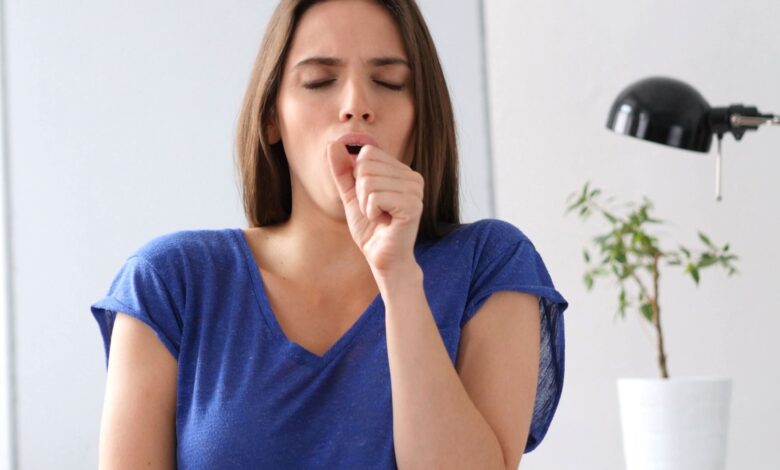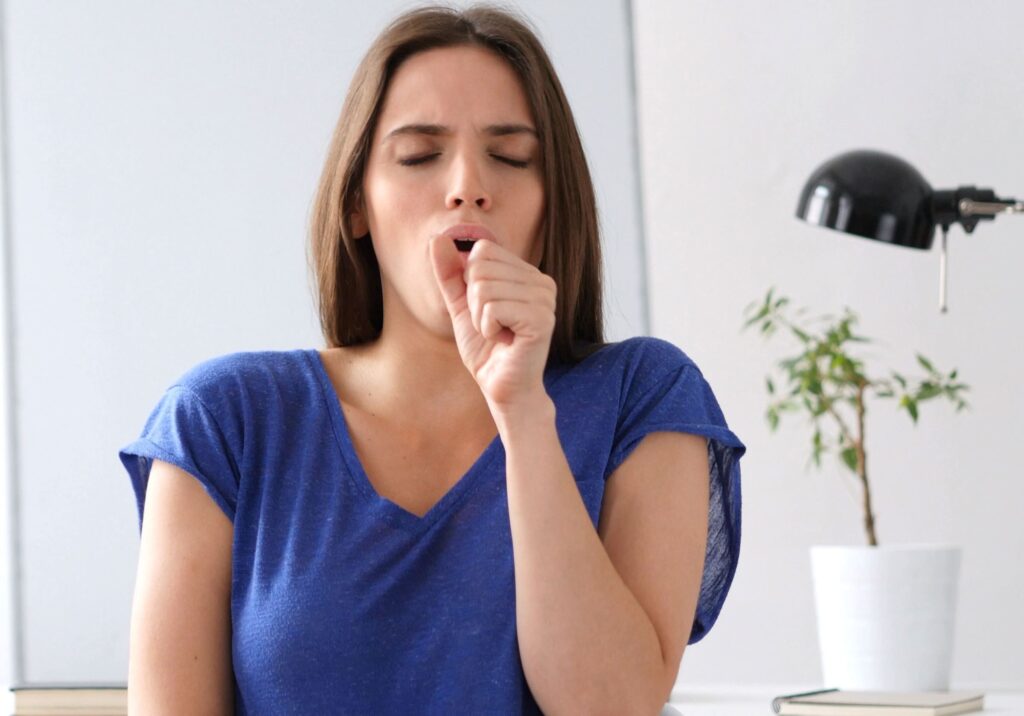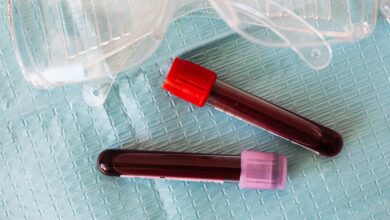
Bronchitis is characterized by inflammation of the bronchi, the tubes that carry inspired air from the trachea to the lungs. Inflammation makes it harder to breathe because the walls of the bronchi are swollen and produce a large amount of mucus. Bronchitis is accompanied by a deep cough.
Discover more details in this sheet.
Acute bronchitis, what is it?
Bronchitis is characterized by inflammation of the bronchi, the tubes that carry inspired air from the trachea to the lungs. Inflammation makes it harder to breathe because the walls of the bronchi are swollen and produce a large amount of mucus. Bronchitis is accompanied by a deep cough.
For the vast majority of people, bronchitis lasts 2-3 weeks and is not problematic. However, the cough may persist for a little longer. This bronchitis is called acute bronchitis to distinguish it from chronic bronchitis, which lasts more than 3 months a year.
Acute bronchitis most often occurs in the fall or winter. It is frequent: the majority of individuals are affected at least once during their life.
Remark. People who contract acute bronchitis and whose bronchi are weakened by another respiratory disease, such as asthma, have more pronounced symptoms. In addition, the risks of complications and the treatments are different. This will not be discussed in this sheet.
Symptoms of acute bronchitis
- A deep cough. The cough intensifies when lying down, outdoors when the air is cold and dry, and if the air is laden with irritating substances, such as cigarette smoke;
- viscous sputum that is light, yellowish or greenish in color;
- general malaise: chills, fatigue, loss of appetite, headaches, body aches. There may be a slight fever;
- chest pain and a feeling of compression of the lungs;
- a short breath.
| Remark. Sometimes bronchitis is accompanied by sinusitis, pharyngitis or laryngitis. In case of pharyngitis, the throat is irritated and there is pain when swallowing. In case of laryngitis, the voice becomes hoarse or goes out altogether. |
Causes of acute bronchitis
A viral infection
The most common cause of acute bronchitis is a viral infection. The viruses are inhaled, then spread to the bronchi. Often a cold or flu precedes bronchitis. Viral bronchitis is contagious.
A bacteria
More rarely, the infection can be caused by bacteria (for example, those that can also cause pneumonia) or by whooping cough.
Lung irritation
Inhaling fine particles in the air that irritate the lungs, such as those in cigarette smoke and fumes from a wood stove, can trigger or worsen bronchitis. A strong presence of mold can also be irritating, as can dust or toxic gases in the workplace, as well as smog. Once inhaled, these particles weaken the lining of the respiratory tract. In particular, they would trigger inflammatory reactions.
Some people are more sensitive to it. This is particularly the case for children and people who suffer from allergic rhinitis or asthma. In parts of Africa and Southeast Asia, the problem is dire. Several acute or chronic respiratory infections are generated by the smoke produced by burning coal when cooking food 1 . Women and young children are the most affected, sometimes fatally.
asthma
Finally, acute bronchitis can also be a sign of asthma. In fact, during studies, researchers have observed that many people who consult a doctor for acute bronchitis actually have asthma without knowing it 22 .
Risk factors for acute bronchitis
- Smoking and exposure to second-hand smoke;
- live or work in a place where chemicals circulate in the air and irritate the lungs;
- be exposed to heavy air pollution. In times of fog (smog), cases of bronchitis are more frequent. In addition, the fog accentuates the symptoms of bronchitis
People at risk of acute bronchitis
- children and the elderly;
- people whose immune system is weakened by chronic stress, by another disease, etc. ;
- people with asthma, chronic bronchitis, emphysema or heart failure;
- people with cystic fibrosis, as their bronchial tubes remain blocked with secretions, which contributes to infections.
Evolution of acute bronchitis
A simple bronchitis is not worrying in a healthy person. In the majority of cases, the symptoms disappear on their own without treatment within 21 days.
If bronchitis persists for more than 3 months or if repeated bronchitis occurs, it is important to get the right treatments. See a doctor again (see our Chronic Bronchitis fact sheet).
On the other hand, it happens that acute bronchitis worsens into pneumonia. This is more common in older people.
The measures to prevent bronchitis and its recurrences are: good lifestyle habits (= not smoking, strengthening your immune system), preventing colds and flu, and ensuring air quality…
Discover all of these preventive measures in this sheet.
Measures to prevent acute bronchitis and its recurrences

The following tips will prevent acute bronchitis, as well as its recurrence or chronicity.
Life habits
Do not smoke or be exposed to second-hand smoke
Smoking has been shown to inflame the bronchial tubes and trigger coughing spells. Another important consequence: the smoke thickens the secretions and paralyzes the bronchial cilia responsible for expelling the secretions. It seems that quitting smoking has the most positive effect on the prevention of bronchitis .
Strengthen your immune system
Rest, physical exercise practiced moderately, but regularly, and healthy eating (meeting your needs for proteins as well as vitamins and minerals, avoiding the abuse of foods high in sugar and saturated fat, etc.) are the basis of good immunity. These measures contribute to preventing infections of all kinds and their recurrence.
To find out more about this, see our Strengthening your immune system fact sheet.
Cold and flu prevention
It is obviously important to guard against common infections, such as colds and flu, since they often precede bronchitis.
A few very simple hygiene measures minimize the risk:
- washing hands frequently;
- bring your hands to your face as little as possible;
- avoid confined spaces where infected people are present.
For people in fragile health, vaccination against influenza and against pneumonia can reduce the risk of contracting bronchitis. Discuss it with your doctor.
To find out more, consult the Prevention section of our Cold and Flu fact sheets.
Pay attention to air quality
As far as possible, the aim is to eliminate or avoid airborne irritants that aggravate or trigger respiratory discomfort: toxic gases, dust in the workplace, etc. Properly maintain combustion appliances and their ventilation system (chimney or exhaust ducts), if applicable. If one is at risk, it is best to avoid outdoor activities when air pollution is high.
Although acute bronchitis often heals on its own, it is important to see a doctor for proper diagnosis and treatment.
See the full list of these medical treatments below.
How to treat acute bronchitis?
Although acute bronchitis usually heals on its own, it is important to consult a doctor in order to have an accurate diagnosis, and all the more so when the following symptoms appear:
- a high or sustained fever;
- shortness of breath, especially if it gets worse when lying down;
- sputum containing blood;
- severe chest pain;
- a general feeling of weakness which is accentuated.
The doctor examines the lungs using a stethoscope and makes specific recommendations based on the cause of the bronchitis and the symptoms reported.
The cough usually clears up on its own within a few days without treatment. In case of nocturnal cough, the use of a humidifier in the room brings relief.
In more severe cases, if the doctor suspects pneumonia or another lung problem, a chest X-ray may be indicated.
Home care
- Take rest ;
- hydrate well. Drink at least 8 cups a day of water and hot drinks, such as tea and broths;
- to help liquefy mucus and promote its expulsion from the bronchi, maintain a humidity level of 30% to 50% indoors, by ventilating the rooms well (if necessary, use a cold or warm steam humidifier). Taking warm baths is also beneficial;
- throughout illness, avoid exposure to smoke, cold air and air pollutants as much as possible;
- follow the other healthy lifestyle measures described in the Prevention section.
Medications
If necessary, various medications can improve the patient’s comfort.
Antitussifs
It’s best not to take over-the-counter cough remedies, such as dextrometorphan (DXM) or codeine syrup. Indeed, coughing has the function of evacuating mucus and clearing the airways. However, if the cough interferes too much with sleep or usual activities, these remedies may offer helpful relief. However, it should be noted that their effectiveness is limited or even non-existent for many adults 21,23 and that their use is not recommended for children.
Bronchodilators
In case of wheezing or rales, the use of a drug that has the effect of opening the bronchi often helps. The physician may then consider prescribing a beta2 agonist bronchodilator in the form of an inhaler (eg, salbutamol or Ventolin®).
Bronchial thinner
Guaifenesin, for example, has an expectorant effect that liquefies bronchial secretions. It is found in the active ingredients of some cough syrups or decongestants (for example, Robitussin Chest Congestion®). However, according to studies, it is not certain that these drugs are really more effective than a placebo 18 .
Antibiotics
In the vast majority of cases, bronchitis is caused by a virus. Antibiotics are then of no use. In addition, the greenish-yellow color of the secretions is not an indicator of bacterial infection and does not justify the prescription of antibiotics. However, if a bacterial infection is diagnosed, antibiotics may sometimes be prescribed.
For sore throats or headaches, aspirin (for adults only), acetaminophen (Tylenol®, Panadol®, etc.) or ibuprofen (Advil®, Motrin®, etc.) may bring relief.
As part of its quality approach, Passeportsanté.net invites you to discover the opinion of a health professional.
Dr. Dominic Larose, emergency physician, gives you his opinion on acute bronchitis.
Dr. Dominic Larose’s opinion on acute bronchitis
“Do you have a cough and colored sputum? You see your doctor, which is good. He diagnoses acute bronchitis. At this precise stage, many patients insist on receiving a prescription for antibiotics. In reality, antibiotics are not useful for a healthy person with acute bronchitis.
Help your doctor: tell him that you just want a good exam and that you don’t necessarily expect him to “do something” at all costs. Most of the time, an assessment of symptoms and a physical exam are sufficient. Time will fix things.
For smokers, what a great opportunity to quit!
Dr Dominic Larose, M.D.
Complementary approaches to acute bronchitis are cape geranium, thyme and primrose, climbing ivy, eucalyptus, liquorice…
Discover them all in this complete and detailed list.
Complementary approaches for acute bronchitis

Cape geranium (Pelargonium sidoides)
Several clinical trials indicate that the liquid plant extract of Pelargonium sidoides (EPs 7630®, a German product) relieves the symptoms of acute bronchitis and accelerates remission more effectively than a placebo . This extract has also been tested with children and adolescents with bronchitis: it seems just as effective and safe, according to 2 studies .
The treatment of respiratory problems using this extract is an increasingly popular practice in Germany. However, it is not available in stores in Quebec.
Dosage: the usual dosage of the standardized extract EPs 7630® is 30 drops, 3 times a day. The dosage is reduced for children. Follow the manufacturer’s information.
Thyme (Thymus vulgaris) and primrose root (Primulae radix)
Four clinical trials support the effectiveness of the thyme-primrose combination in moderately reducing the duration and intensity of bronchitis symptoms. During one of these studies, the Bronchipret® preparation (a syrup containing an extract of thyme and primrose root) was shown to be as effective as 2 drugs that thin bronchial secretions (N-acetylcysteine and ambroxol) .
Note, however, that this preparation is not available in Quebec. The German Commission E recognizes the effectiveness of thyme for the treatment of symptoms of bronchitis. Dosage This herb can be taken internally as an infusion, fluid extract or tincture. Consult the Thyme file (psn).
Climbing ivy (Hedera helix)
The results of 2 clinical trials underline the effectiveness of 2 cough-relieving syrups (Bronchipret Saft® and Weleda Hustenelixier®, German products). These syrups contain as main ingredient an extract of climbing ivy leaves. Note that they also contain an extract of thyme, a plant whose virtues to relieve cough and bronchitis are recognized.
Moreover, the results of a pharmacovigilance study indicate that a syrup containing an extract of ivy leaves can effectively relieve the symptoms of acute or chronic bronchitis 15 . The use of climbing ivy to treat bronchial inflammation is further endorsed by Commission E.
Dosage: consult our Climbing Ivy sheet.
Andrographis (Andrographis paniculata)
The World Health Organization recognizes the use of andrographis for the prevention and treatment of uncomplicated respiratory infections, such as the common cold, sinusitis and bronchitis. This plant is used in several traditional Asian medicines to treat fever and respiratory infections.
Dosage: Take 400 mg of standardized extract (containing 4% to 6% andrographolide), 3 times a day.
Eucalyptus (Eucalyptus globulus)
Commission E and the World Health Organization have approved the use of the leaves (internal route) and essential oil (internal and external routes) of Eucalyptus globulus to treat inflammation of the respiratory tract, including bronchitis , thus confirming an old practice of traditional herbalism. Eucalyptus essential oil is part of many pharmaceutical preparations for respiratory tract conditions (Vicks Vaporub®, for example).
Dosage: consult our Eucalyptus sheet.
Caution: Eucalyptus essential oil should be used with caution by certain people (eg asthmatics). Consult the Precautions section of our Eucalyptus sheet.
Licorice (Glycyrrhiza glabra)
Commission E recognizes the effectiveness of licorice in treating inflammation of the respiratory system. The European tradition of herbalism attributes to licorice a softening action, that is to say that it has the effect of calming the irritation of inflammations, in particular those of the mucous membranes. It seems that licorice also strengthens immune functions and that it could thus help fight infections responsible for inflammation of the respiratory tract.
Dosage: consult our Licorice sheet.
Combination of plants
Traditionally, medicinal plants have often been used in combination. Commission E recognizes the effectiveness of the following combinations in reducing the viscosity of mucus and facilitating its expulsion from the respiratory tract, reducing bronchial spasms and neutralizing microbes :
- eucalyptus essential oil, evening primrose root and thyme;
- climbing ivy, liquorice and thyme.
Other medicinal plants have traditionally been used to relieve the symptoms of bronchitis. This is the case, for example, of angelica, astragalus and balsam fir.
Consult our files to find out more.
Dietary change
Dr. Andrew Weil recommends that people with bronchitis stop consuming milk and dairy products . He explains that casein, a milk protein, can irritate the immune system. On the other hand, casein would stimulate the production of mucus. However, this opinion is not unanimous, and would not be supported by studies. People who exclude dairy products must ensure that they meet the body’s calcium needs with other foods.
On this subject, consult our Calcium sheet.
Chinese pharmacopoeia
The Xiao Chai Hu Wan preparation is indicated in Traditional Chinese Medicine to treat infectious diseases, when the body has difficulty fighting them.














